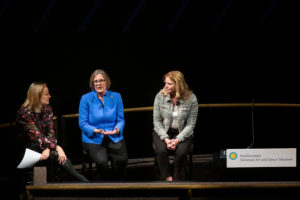November 19, 2019
The Changing Face of Air and Space
Posted by Kasia Kornecki

Women Rule editorial director Anna Palmer (left) was joined on stage by Kathryn Sullivan (center) and Ellen Stofan (right).
Even with a façade that is currently under renovation (and will continue to be for the next seven years), the inside of the Smithsonian Air and Space Museum is as inspiring as ever. Many young people are moved to pursue science thanks to a visit to the museum, but walking past rockets, moon landers, and photos from the final frontier can be just as exhilarating for adults. The museum served as the venue for Politico’s recent Women Rule event, and it certainly heightened the sense of excitement felt by everyone in attendance.
Women Rule is an event series dedicated to empowering future female pioneers and expanding leadership opportunities to women in all stages of their careers. The most recent event in Washington DC was for women in STEM fields. The panelists were Kathryn Sullivan, Chair of Aerospace History at the Smithsonian Air and Space Museum, former NOAA Administrator, and the first American woman to walk in space in 1984, and Ellen Stofan, Director of the Smithsonian Air and Space Museum, and former NASA scientist. And these women didn’t hold back! The discussion opened with a question about how they felt about the first all-female spacewalk that happened a few weeks ago, and Kathy remarked, “It took [NASA] long enough!”
The culprit: spacesuits. Originally, and for decades to follow, spacesuits were designed to be worn by men. Both panelists commented that in the 80s, NASA went out of its way to make special spacesuits for larger (male) astronauts, but women were expected to make-due with existing sizes. The decades-long lack of action on making female-specific modifications resulted in what Kathy described as “a suit that disenfranchises women.”
A recent Washington Post article describes some of the hurdles women have to overcome to use ill-fitting equipment, with a positive outlook towards a more egalitarian suit design moving into NASA’s 2028 Artemis mission. Ellen mentioned that in early missions like Mercury and Gemini, staff scientists were noticing that from a biological perspective, smaller size was actually an advantage for space exploration. She said, “Women appeared to be well suited for space travel,” – no pun intended – but the culture at the time didn’t encourage further inquiry into the matter.
The conversation soon shifted to engaging the next generation in STEM education. Both speakers agreed that there’s a flawed cultural narrative in the US that being “good at” STEM is somehow intrinsic and not learned. Both women lamented that perhaps that attitude is part of the reason many young people don’t even try. Kathy pointed out that “In other countries, people treat [STEM education] more like sports: you can train and get better. You can be good at this, and it’s worth working at.”
Ellen tied that flawed narrative in with current preconceptions about what it means to be a scientist: white men in white coats. Part of getting young people excited about STEM involves creating an environment where kids can see that scientists look like them. On top of creating a more inclusive community with varied approaches to problem solving, increasing diversity in STEM creates role models that inspire the next generation to pursue science. Both speakers agreed that encouraging diversity may be the ultimate fix to the STEM pipeline problem.
To deliver on fixing the pipeline problem, Kathy and Ellen are spearheading a Women’s Air and Space History exhibit as part of the museum’s renovation project. Meanwhile, a proposed National Women’s History Museum is still waiting on a motion from Congress to see whether or not a physical museum will be in its future.
Kathy’s book Handprints on Hubble was recently published and speaks to her experience as one of the first female pioneers in space.
Kasia Kornecki is an intern for AGU’s Public Affairs team. She is a Ph.D. chemist and is interested in policy related to climate, clean energy, and science education.



[…] Fonte/Source: https://blogs.agu.org/thebridge/2019/11/19/the-changing-face-of-air-and-space/ […]